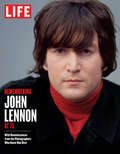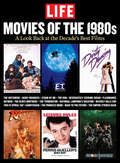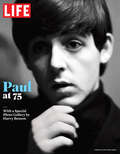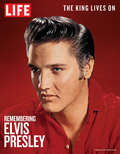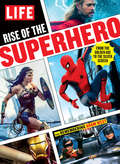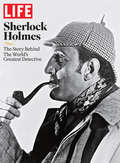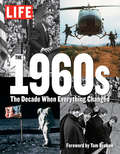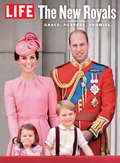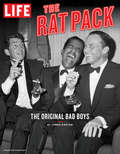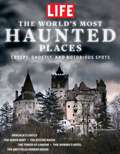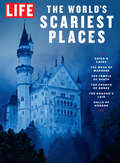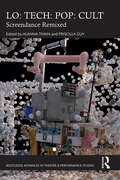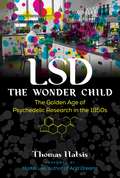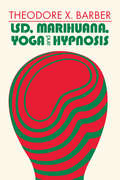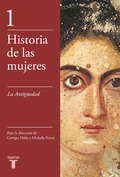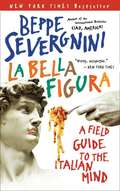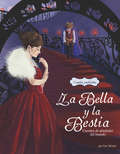- Table View
- List View
LIFE Inside the Disney Parks: The Happiest Places on Earth
by The Editors of LIFEWalt Disney spent his life dreaming impossible dreams, and achieved the most impossible dream of all - the amusement park to end all amusement parks: Disneyland!
LIFE James Dean: A Rebel's Life in Pictures
by The Editors of LifeLIFE Magazine memorializes actor James Dean.
LIFE Movies of the 1980s: A Look Back at the Decade's Best Films
by The Editors of LIFETravel back to the future with dozens of 1980s favoritesBefore the internet, in the days of Rubik's Cubes, the Iran-Contra scandal, and Wall Street's booms and busts, movies captured the spirit of our times. Now you can revisit those great films with LIFE Movies of the 1980s, packed with glowing photos and behind-the-scenes stories from the pages of Life magazine.
LIFE Paul at 75
by The Editors of Life Tony SchermanLIFE celebrates the 75th birthday of renowned musician Sir Paul McCartney.
LIFE Remembering Elvis Presley: The King Lives On
by The Editors of LifeHe will always be the KingCelebrate the King of Rock 'n' Roll with this keepsake biography of Elvis Presley, lavishly illustrated with dozens of historic photos, including many from the archives of Life magazine. A detailed timeline traces Elvis's life from when he received his first guitar to his glory days filled with recording, acting and gyrating for shrieking fans, to his great '68 comeback comeback, and right up to his untimely death in 1977. Intimate photojournalism combines with insightful text to reveal Elvis behind the scenes . . . at Graceland and on the road, with Priscilla and Lisa Marie, in front of the cameras, and on the stage. Explore the days of "Heartbreak Hotel," "Don't Be Cruel," "Blue Suede Shoes," "Jailhouse Rock," "Love Me Tender," "Blue Christmas" and so many other unforgettable hits. It's now or never-so you should probably pick up your copy today.
LIFE Remembering Kurt Cobain: 20 Years Later
by The Editors of LifeLIFE Magazine remembers Nirvana's Kurt Cobain.
LIFE Remembering Kurt Cobain: The Icon at 50
by The Editors of LifeLIFE Magazine remembers Nirvana's Kurt Cobain.
LIFE Remembering Lauren Bacall, 1924-2014 (LIFE Special Issue Magazine)
by The Editors of LIFELIFE Magazine remembers actress Lauren Bacall.
LIFE Remembering Marilyn
by The Editors of LifeRemembering the iconic star through intimate photos and essaysMore than fifty years after her death, Marilyn Monroe remains as famous as ever. Rediscover the screen legend with dozens of intimate photos from the archives of LIFE magazine. Insightful text reveals Monroe's journey from Norma Jeane to international star and American icon. Includes special access to the famous "Happy Birthday, Mr. President" performance for John F. Kennedy as well as the more than 30 movie roles that made her an icon. Some Like It Hot . . . The Seven-Year Itch . . . Gentlemen Prefer Blondes . . . The Misfits . . . these classic movies and her performances in them made her one of Hollywood's most glamorous stars. Her personal life, with marriages to Arthur Miller and Joe DiMaggio, and rumored affairs with John F. Kennedy and Bobby Kennedy, made her fascinating. LIFE Remembering Marilyn lets readers see Monroe's remarkable life both in front of the cameras and behind the scenes.
LIFE Rise of the Superhero: From the Golden Age to the Silver Screen
by The Editors of LIFEToday, superheroes are more popular than ever, with action-packed movies, TV shows, comic books, graphic novels, and other genres celebrating them. The craft has become more sophisticated, the stories more intricate, with the entire art-form now elevated and celebrated. For as long as characters such as Batman, Wonder Woman, Spider-Man, Thor, Captain America, etc. have been a part of popular culture, the oldest "modern" superhero is only just over 80 years old, that being Superman. Now, in a new Special Edition from LIFE, Rise of the Superhero, which includes an introduction by the legendary Stan Lee, the editors of LIFE trace the superhero phenomenon from its earliest days, then explores the superheroes of today, through historical and current photographs and entertaining text. Essays place the evolution of various superheroes throughout the context of world events through each decade, antiheroes are explored, and the technology that has been used to create the movies and comic books - and influenced the stories - is explained, giving the reader a complete and concise history of the genre. An exclusive bonus showcases the great Adam West, the original TV Batman, with little-seen photos.
LIFE Sherlock Holmes: The Story Behind the World's Greatest Detective
by The Editors of LIFEWith season 4 of the popular Benedict Cumberbatch series, Sherlock, about to air on BBC One and another Robert Downey movie about the great detective in the works, LIFE offers a colorful look back on the life and career of the immortal sleuth, along with a biography of his remarkable creator, Arthur Conan Doyle. Did you know that Holmes was based on a real person? Or that Doyle came to hate him? Or that the writer solved more than a few real-life mysteries himself? You'll find that and much more in this entertaining, immersive, informative new book.
LIFE The 1960s: The Decade When Everything Changed
by Tom Brokaw The Editors of LIFEHere are the 1960s: The Summer of Love, the space race, Vietnam, the assassination of JFK, Andy Warhol, the Berlin Wall, the Beatles. From start to finish, this is the decade when everything changed—when we changed. With insightful commentary and hallmark photography from the archives of LIFE magazine, LIFE: The 1960s reveals the turmoil and triumphs of the most tumultuous decade in American history. The shifting people, places, and events are placed in historic context, year by year from 1960 to 1969, and illuminated with award-winning, iconic photos. A thought-provoking introduction by Tom Brokaw spotlights the enduring legacy of these years, powered by the baby boomers and their quest for love, liberty, and equality. Discover the decade as it unfolded.
LIFE The New Royals
by The Editors of LifeThe aura around the royal family is vastly different than it was in years and decades past. Now, 20 years after the death of the transformative Princess Diana, today's generation of royals are active and engaged, using the power of their position to advance causes for the good of the community. Prince William and Prince Harry, inspired by the example set by their mother, have embraced charities and causes that include mental health and aid wounded veterans. Kate Middleton and her children, little Prince George and Princess Charlotte, are out and about, visible in ways that royals never were before. This is the world that Kate and William's newest child-she is due in early 2018-will enter. The new royals are still glamorous, and now they are more inspiring than ever. LIFE The New Royals highlights the young generations of Windsors with glowing photographs of them, as well as archival photographs of Charles, Diana, the Queen and more, along with rich and thoughtful reporting on one of the world's best-known families. This special edition also includes a family tree of the Windsors and a section on the new generations of royals throughout the world. Packed with dozens of unforgettable images, including the wedding of William and Kate and the latest adorable antics of their children, this is a memorable keepsake for royal watchers everywhere.
LIFE The Rat Pack: The Original Bad Boys
by The Editors of LifeThey weren't the original bad boys of stage and screen, but they were the most famous: Frank Sinatra, Dean Martin, Sammy Davis Jr., Joey Bishop, Peter Lawford and so many hangers-on and wannabes, male and female. Revisit the '60s in this reissue of a classic LIFE special edition-the Rat Pack is in town. Among the highlights:A new introduction, commemorating what would have been Dean Martin's 100th birthdayInside the friendship between Sinatra and John F. Kennedy Jr.The birth of Vegas and how Sin City became the sensation it is todayRare and intimate photos from the great LIFE magazine photographer John Dominis
LIFE The World's Most Haunted Places: Creepy, Ghostly, And Notorious Spots
by The Editors of LIFELife Magazine presents The World's Most Haunted Places.
LIFE The Worlds Scariest Places
by The Editors of LIFETake an otherworldly world tour of horrifying haunts!This Halloween, visit haunted houses, creepy cemeteries, scary ghost towns, and shocking paranormal hotspots . . . all without leaving the comfort of your own well-lit home.
LO: Screendance Remixed (ISSN)
by Alanna Thain Priscilla GuyThis edited collection assembles international perspectives from artists, academics, and curators in the field to bring the insights of screendance theory and practice back into conversations with critical methods, at the intersections of popular culture, low-tech media practices, dance, and movement studies, and the minoritarian perspectives of feminism, queer theory, critical race studies and more.This book represents new vectors in screendance studies, featuring contributions by both artists and theoreticians, some of the most established voices in the field as well as the next generation of emerging scholars, artists, and curators. It builds on the foundational cartographies of screendance studies that attempted to sketch out what was particular to this practice. Sampling and reworking established forms of inquiry, artistic practice and spectatorial habits, and suspending and reorienting gestures into minoritarian forms, these conversations consider the affordances of screendance for reimaging the relations of bodies, technologies, and media today.This collection will be of great interest to students and scholars in dance studies, performance studies, cinema and media studies, feminist studies, and cultural studies.
LSD — The Wonder Child: The Golden Age of Psychedelic Research in the 1950s
by Thomas Hatsis• Explores the different groups--from research labs to the military--who were seeking how best to utilize LSD and other promising psychedelics like mescaline • Reintroduces forgotten scientists like Robert Hyde and Rosalind Heywood • Looks at the CIA&’s notorious top-secret mind-control program MKUltra • Reveals how intellectuals, philosophers, artists, and mystics of the 1950s used LSD to bring ancient rites into the modern ageExploring the initial stages of psychedelic study in Europe and America, Thomas Hatsis offers a full history of the psychedelic-fueled revolution in healing and consciousness expansion that blossomed in the 1950s--the first &“golden age&” of psychedelic research. Revealing LSD as a &“wonder child&” rather than Albert Hofmann&’s infamous &“problem child,&” the author focuses on the extensive studies with LSD that took place in the &’50s. He explores the different groups--from research labs to the military to bohemian art circles--who were seeking how best to utilize LSD and other promising psychedelics like mescaline. Sharing the details of many primary source medical reports, the author examines how doctors saw LSD as a tool to gain access to the minds of schizophrenics and thus better understand the causes of mental illness.The author also looks at how the CIA believed LSD could be turned into a powerful mind-control weapon, including a full account of the notorious top-secret program MKUltra. Reintroducing forgotten scientists like Robert Hyde, the first American to take LSD, and parapsychologist Rosalind Heywood, who believed LSD and mescaline opened doors to mystical and psychic abilities, the author also discusses how the infl uences of Central American mushroom ceremonies and peyote rites crossbred with experimental Western mysticism during the 1950s, turning LSD from a possible madness mimicker or mind weapon into a sacramental medicine. Finally, he explores how philosophers, parapsychologists, and mystics sought to use LSD to usher in a new age of human awareness.
LSD, Marihuana, Yoga, and Hypnosis
by Theodore X. BarberThe practice of yoga, hypnosis, and the use of psychedelic drugs to alter psychological and physiological states is not unknown to the study of psychology. They have been called "soft" studies and labeled unimportant. This is mostly because they are difficult to study and understand, often focusing on unobservable internal states such as altered states of consciousness, Samadhi, or hypnotic states. This book, in its approach to thinking about this topic and method for analysis, focuses only on phenomena that can be observed, such as behavioral changes.By centering on only those aspects of the psychological and physiological effects of yoga, hypnosis, and psychedelic drugs which can be measured and analyzed using this new method, Barber distinguishes this book from others in the field. He asks what overt behaviors and verbal reports are clearly observable when psychedelic drugs are taken, yoga is practiced, or hypnotic-induction procedures are administered. Instead of treating the phenomena traditionally associated with psychedelic drugs, yoga, or hypnosis as undifferentiated conglomerates, an attempt will be made to set apart and treat separately each of the many phenomena associated with each of these areas of inquiry.This book does not set out to simply demonstrate the importance of psychedelics, yoga, and hypnosis, or to present substantive material pertaining to these topics. It also treats each topic as continuous with other known psychological phenomena and as an important piece to the puzzle of social psychology. It differs from most previous treatises in that it does not assume that psychedelics, yoga, and hypnosis can bring out unused mental or physical capacities in man, heighten awareness or give rise to enhanced creativity, or produce altered states of consciousness, suspension of conventional reality-orientation, changes in body-image, or changes in perception.
La Antigüedad: La Antigüedad (Historia de las mujeres #Volumen 1)
by Georges DubyEsta obra busca analizar cómo las relaciones de los sexos condicionan la evolución de las sociedades y la necesidad de que las mujeres encuentren, al fin, su espacio propio. Esta Historia de las mujeres responde a la necesidad de ceder la palabra a las mujeres. Alejadas, desde la Antigüedad, del escenario donde se enfrentan a los dueños del destino, reconstruir su historia significa describir su lento acceso a los medios de expresión y su conversión en persona que asume un papel protagonista. Este análisis implica, asimismo, que las relaciones entre los sexos condicionan los acontecimientos, o la evolución de las sociedades. No se buscan conclusiones tajantes sino que las mujeres encuentren, al fin, su espacio propio. Tomando la periodización habitual y el espacio del mundo occidental, esta obra se divide en cinco volúmenes independientes pero complementarios. Este primer volumen trata de las funciones y roles sociales de las mujeres en la Grecia antigua y en Roma.
La Argentina (Edición Corregida y Actualizada): Historia del país y de su gente
by María Sáenz QuesadaSáenz Quesada sintetiza el recorrido histórico y cronológico que vadesde la fundación de la sociedad colonial hasta la actualidad. Son 74capítulos pensados para ser leídos en forma independiente, que incluyenlos hechos políticos sobresalientes, pero también referencias a la vidaprivada, rasgos biográficos de los protagonistas, el clima de ideas y lasensibilidad de cada época, además de ejemplos para que el pasado sehumanice y se vuelva más cercano y comprensible. Este singular relato historiográfico abarca la construcción de laRepública del siglo XIX, la gran inmigración y la prosperidad económica,la inestabilidad política en el siglo XX y la crisis de comienzos delmilenio, la debacle del 2001y el período de recuperación iniciado conlas presidencias de Néstor Kirchner y Cristina Fernández.Serio y entretenido a la vez, este libro se constituye en una obraindispensable para el conocimiento y el estudio de la historiaargentina, y resulta un excelente auxiliar en la indagación de laidentidad.
La Argentina ansiolítica: Medicados y automedicados: cómo nos están cambiando la vida las pastillas
by Valeria ShapiraLa medicalización de la vida cotidiana es un fenómeno que se repite encada vez más países, pero la forma en que los argentinos serelacionan con pastillas de todo tipo presenta sus particularidades.Shapira las aborda sin prejuicios y con humor. Un hombre que llega a la guardia de una clínica con síntomas de ataquede pánico, una abuela que discute con el cura de la iglesia sobre sunecesidad de visitar a un psiquiatra, un ejecutivo que odia laspastillas y prefiere el diván, una mujer fóbica a los aviones que nuncaviaja sin su pastilla «mágica» o una chica que logró terminar su carreracon la ayuda de ansiolíticos son algunos de los personajes anónimos quetransitan las páginas de este libro.Durante los últimos años, en ese sector de la población que todavíallamamos clase media se instaló una costumbre cada vez más difundida: lade salir a la calle con un ansiolítico en el bolsillo. «La Argentinaansiolítica» recoge historias de vida de argentinos que tienen otuvieron un vínculo con esos medicamentos que la ciencia consiguiómejorar desde los años 70, y cuyo uso suele vincularse con la denominadamedicalización de la vida cotidiana.Con una prosa ágil, directa y nunca exenta de humor, Valeria Shapiraabre las puertas a esa realidad que pasa delante de nuestros ojos, sinpretender planteos técnicos o cientificistas en torno de estas drogasque hoy se cuentan entre las más vendidas. Más que entregar fórmulas, laautora abre preguntas: ¿por qué todavía estigmatizamos a quienes tomanansiolíticos? ¿Es necesario enfrentar las pastillas y el diván, en unpaís con tradición psicoanalítica tan fuerte? ¿Pretendemos tratar lascrisis nacionales con remedios, en lugar de buscar soluciones políticaso económicas? ¿Quién se atreve a negar que vivimos automedicados?La Argentina ansiolítica invita a conocer, sin prejuicios, los caminosque cada uno busca para lidiar con su ansiedad en este rincón del mundodonde la angustia y la incertidumbre cotidianas son parte de nuestramarca país.
La Bella Figura: A Field Guide to the Italian Mind
by Beppe SevergniniJoin Beppe on a lively tour of modern Italy that takes you behind the seductive face it puts on for visitors and finds Italy's true self.
La Bella y la Bestia: 3 cuentros predilectos de alrededor del mundo (Cuentos multiculturales)
by Cari MeisterThink there's just one fairy tale with a beautiful girl and a monster? Think again! Cultures all around the world have their own Beauty and the Beast stories. Visit France, China, and Switzerland, to find out who asks for a grape instead of a rose, and whose beast is a snake. Fully translated Spanish text.


